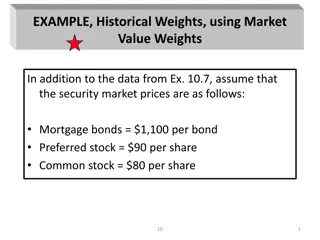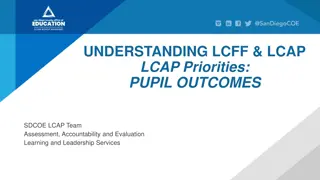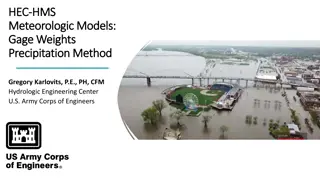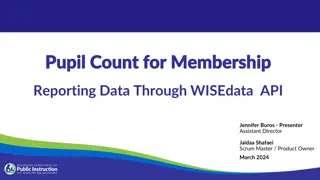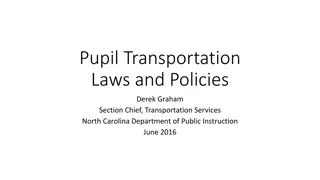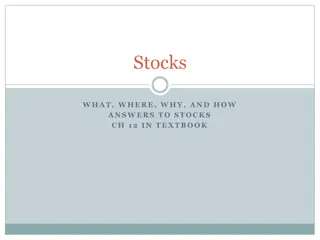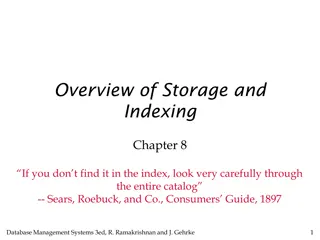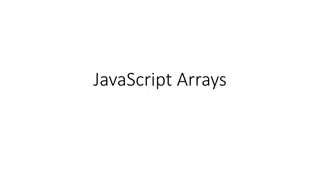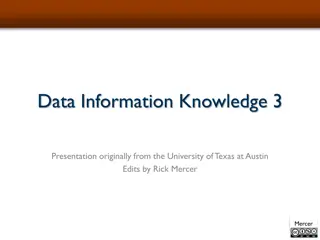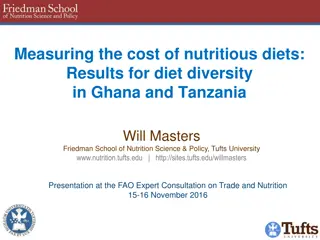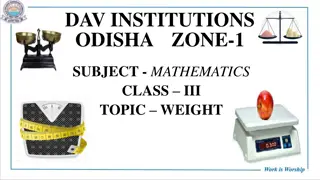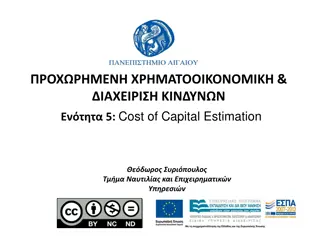Cost Indexes and Pupil Weights in Public Finance Seminar
Explore the importance of cost indexes and pupil weights in public finance, focusing on expenditure needs, cost disparaties, and aid programs. Key concepts like expenditure need, cost index, and pupil weight are discussed along with the cost function and expenditure requirements to meet performance targets. Dive into the complexities of public service costs and strategies for equitable distribution of resources.
Download Presentation

Please find below an Image/Link to download the presentation.
The content on the website is provided AS IS for your information and personal use only. It may not be sold, licensed, or shared on other websites without obtaining consent from the author. Download presentation by click this link. If you encounter any issues during the download, it is possible that the publisher has removed the file from their server.
E N D
Presentation Transcript
PUBLIC FINANCE SEMINAR PUBLIC FINANCE SEMINAR SPRING 2021, PROFESSOR YINGER SPRING 2021, PROFESSOR YINGER Cost Indexes and Pupil Weights
Cost Indexes and Pupil Weights Cost Indexes and Pupil Weights Class Outline Class Outline Cost Indexes and Expenditure Need Pupil Weights Other Approaches
Cost Indexes and Pupil Weights Cost Indexes and Pupil Weights Class Outline Class Outline Cost Indexes and Expenditure Need Pupil Weights Other Approaches
Cost Indexes and Pupil Weights Cost Indexes and Pupil Weights Costs and Policy, 1 Costs and Policy, 1 The local governments created by a state face different costs for providing the services they are expected to provide. In some cases, these cost disparities are regarded as unfair and state aid programs are designed to minimize or even offset them. The main example of this type of aid program is aid to elementary and secondary education. We will introduce this application today and return to it in later classes. But the issue of public service costs arises in the case of other services as well. Some local governments must pay more than others to obtain the same level of governmental performance.
Cost Indexes and Pupil Weights Cost Indexes and Pupil Weights Costs and Policy, 2 Costs and Policy, 2 Key Concepts: Expenditure need = the amount a jurisdiction must spend to meet a given set of performance objectives Cost index = an index of expenditure need relative to a baseline Pupil weight = a component of cost associated with a particular type of student
Cost Indexes and Pupil Weights Cost Indexes and Pupil Weights The Cost Function The Cost Function where S = spending per pupil T = performance measures Z = controls for efficiency, etc. P = input prices C = share of students in a category
Cost Indexes and Pupil Weights Cost Indexes and Pupil Weights Expenditure Need Expenditure Need Expenditure need (EN) is the spending required to meet a performance target if non-cost factors are set at the state-wide average and cost factors are allowed to vary across districts. Endogenous cost factors (wages) must be predicted. Let a tilde (~) indicate a target, a bar (-) indicate an average, and a hat (^) indicate a predicted value (from 2SLS). Then .
Cost Indexes and Pupil Weights Cost Indexes and Pupil Weights Expenditure Need, 2 Expenditure Need, 2 EN for district j is EN for the average district is
Cost Indexes and Pupil Weights Cost Indexes and Pupil Weights Cost Index Cost Index The cost index for district j is its own EN divided by EN in the average district, or With these forms, EN does not depend on the target performance.
Cost Indexes and Pupil Weights Cost Indexes and Pupil Weights Results from D/Y, Results from D/Y, EER EER, 2005 , 2005
Cost Indexes and Pupil Weights Cost Indexes and Pupil Weights Questions Questions What is a local government s expenditure need? What does a study of expenditure need tell us about local governments? What is a public cost index? How is it related to expenditure need?
Cost Indexes and Pupil Weights Cost Indexes and Pupil Weights Class Outline Class Outline Cost Indexes and Expenditure Need Pupil Weights Other Approaches
Cost Indexes and Pupil Weights Cost Indexes and Pupil Weights Pupil Weights Pupil Weights In the case of education, these concepts can be used to define pupil weights, which indicate the increased spending required to reach a given performance target for a student in a given cost category. A student from a family in poverty may require more spending to reach a given performance target than a student from a non-poor family. Although few studies apply this concept to other cases, it might also be true that a poor family raises the cost or police services per household. These weights can be used in state aid formulas. Most states have pupil weights in their aid formula for elementary and secondary education. As we will see, cost functions and pupil weights are related concepts.
Cost Indexes and Pupil Weights Cost Indexes and Pupil Weights Pupil Weights, 2 Pupil Weights, 2 Expenditure Need with No Disadvantaged Students Impact of Disadvantaged Students
Cost Indexes and Pupil Weights Cost Indexes and Pupil Weights Pupil Weights, 3 Pupil Weights, 3 Weight = Extra Cost per Pupil as a Share of No-Disadvantaged- Student Spending
Cost Indexes and Pupil Weights Cost Indexes and Pupil Weights Cost Indexes vs. Weights Cost Indexes vs. Weights The D/Y article shows that a district s measure of expenditure need is approximately the same regardless of whether it is based on a cost index or pupil weights. With only one measure of student disadvantage, the two approaches yield exactly the same result.
Cost Indexes and Pupil Weights Cost Indexes and Pupil Weights Direct Estimation of Weights Direct Estimation of Weights An alternative, non-linear approach is to estimate This yields the weights directly and gives similar results.
Cost Indexes and Pupil Weights Cost Indexes and Pupil Weights Pupil Weights in NY Pupil Weights in NY The D/Y article estimates pupil weights for school districts in New York State. The resulting weights are significantly higher than the weights in the New York state aid formula at the time. The weights in that formula have subsequently been raised, although not to the levels estimated by D/Y.
Cost Indexes and Pupil Weights Cost Indexes and Pupil Weights D/Y, D/Y, EER EER, October 2005 , October 2005 Estimated Pupil Weights Pupil- Weighted Average Simple Average Directly Estimated Without Special Education Child Poverty 1.415 1.491 1.667 LEP 1.007 1.030 1.308 With Special Education Child Poverty 1.224 1.281 1.592 LEP 1.009 1.033 1.424 Special Education 2.049 2.081 2.644
Cost Indexes and Pupil Weights Cost Indexes and Pupil Weights Pupil Weights in NY, 2 Pupil Weights in NY, 2 These weights have an enormous impact on the cost of education. The 2011 census poverty rate is 43.4% for Syracuse and 46.1% for Rochester. Just from this factor, costs are as much as 43.4 1.667 = 72.9% higher in Syracuse than in a district with no poverty. In a typical state, however, the weight in the state aid formula is 10- 20%, not 167%.
Cost Indexes and Pupil Weights Cost Indexes and Pupil Weights Pupil Weights in NY, 3 Pupil Weights in NY, 3 An update from Gutierrez/Yinger (2017): The share of students eligible for a free lunch is the poverty measure with the strongest link to spending. The average district pupil weight for this measure is 1.25. It costs 125% more to bring a poor student up to the same level of student performance as a non-poor student. Estimated weights are 0.61 for ELL students and 0.39 for students with a severe disability. This ELL weight is significantly higher than the 0.5 weight in the current aid formula.
Cost Indexes and Pupil Weights Cost Indexes and Pupil Weights Pupil Weights in NY, 4 Pupil Weights in NY, 4 Gutierrez/Yinger, continued. To attain any given student performance standard, state-wide school spending outside NYC would have to increase by 37.1% to account for the state s economically disadvantaged students, by 2.5% to account for LEP students, and by 6.7% to account for students with severe disabilities.
Cost Indexes and Pupil Weights Cost Indexes and Pupil Weights Pupil Weights in NY, 5 Pupil Weights in NY, 5 Table 1. Required Extra Funding for Free-Lunch Students in NYS s 10 Largest Districts (Excluding NYC) School District 2012 2013 2014 Free Lunch Enroll. Brentwood 64% 81% Buffalo 90% 95% Greece 16% 39% New Rochelle 50% 45% Newburgh 70% 73% Rochester 104% 100% Sachem 13% 14% Syracuse 91% 89% Wappingers 36% 15% Yonkers 85% 88% 2015 Avg. Share Avg. 81% 91% 74% 45% 30% 101% 20% 90% 15% 85% 88% 96% 80% 51% 39% 105% 21% 90% 23% 90% 63% 75% 42% 38% 42% 82% 14% 72% 18% 70% 17,266 30,986 11,092 10,512 10,955 28,958 14,030 19,676 11,550 24,357
Cost Indexes and Pupil Weights Cost Indexes and Pupil Weights Questions Questions What is a pupil weight (in the context of a formula for state aid to education)? How is a pupil weight calculated? What do estimated pupil weights tell us about the cost of education in New York?
Cost Indexes and Pupil Weights Cost Indexes and Pupil Weights Class Outline Class Outline Cost Indexes and Expenditure Need Pupil Weights Other Approaches
Cost Indexes and Pupil Weights Cost Indexes and Pupil Weights Other Approaches to Expenditure Need Other Approaches to Expenditure Need Successful Schools Use spending in districts that reach a performance target (and have similar poverty) Professional Judgment Panels (Ask a group of teachers and administrators what it would cost to reach a performance target in schools with high poverty) Computer-based (Find estimates of required spending from a large sample of teachers and administrators on a computer-based survey. Evidence-based Use program evaluations to estimate the cost required to reach a given performance target.
Cost Functions Cost Functions Teacher Cost Indexes Teacher Cost Indexes Teacher cost indexes are difficult to estimate. The most intuitively plausible method is straightforward: Regress teacher wages on teacher quality, the district classroom environment (e.g. the poverty rate), and characteristics of the local labor market. Predict wages that each district must pay to attract teachers of a given quality in a given labor market (both held constant) and its own environment (allowed to vary).
Cost Functions Cost Functions Teacher Cost Indexes, 2 Teacher Cost Indexes, 2 The trouble is that teacher quality is difficult to measure and variables indicating classroom environment (e.g. the poverty rate) are correlated with unmeasured components of teacher quality. The result is that environmental variables often have the wrong sign and the teacher wage index makes no sense. Another possibility is to use a measure of teacher value-added, but this approach difficult (as discussed in an earlier class) and may not be meaningful at the school district level.
Cost Functions Cost Functions Teacher Cost Indexes, 3 Teacher Cost Indexes, 3 Other approaches include: An index of private wages in occupations with similar educational requirements. Measures of the cost of living or housing costs in the area, or even of population in the area (which is correlated with the cost of living).
Cost Indexes and Pupil Weights Cost Indexes and Pupil Weights Expenditure Need in Cities Expenditure Need in Cities Expenditure need is a general concept that does not apply just to education. Another step in the analysis is to add spending responsibilities. Some cities, for example, have to provide ports, airports, hospitals, or higher education, whereas others do not.
Cost Indexes and Pupil Weights Cost Indexes and Pupil Weights Expenditure Need in Cities, 2 Expenditure Need in Cities, 2 In America s Ailing Cities, Ladd and Yinger calculate expenditure need indexes for the 70 largest cities in the U.S., using a cost index and a service responsibility index. This gives a comprehensive measure of what a city would have to spend to provide a given quality or public services based on factors outside its control.
Cost Indexes and Pupil Weights Cost Indexes and Pupil Weights Expenditure Need in Cities, 3 Expenditure Need in Cities, 3 The results for EN per capita Average: $571 Minimum: $162 Washington, D.C: $3,189 Next highest: $2,251. The 5 cities with population over 1 million had an EN of $879 compared to $509 for the cities with population under 100,000. The lowest income cities had an EN of $890 compared to $409 for the richest cities.


